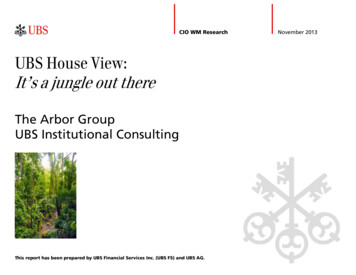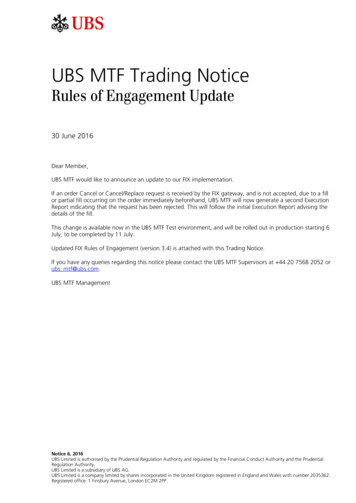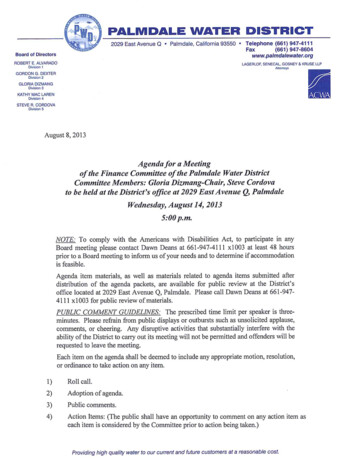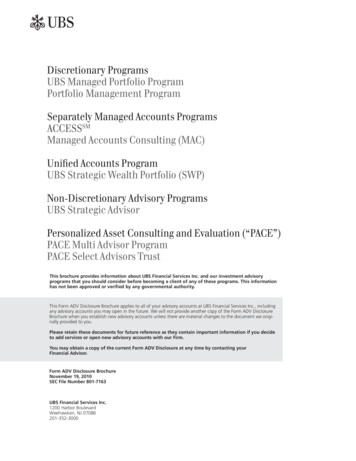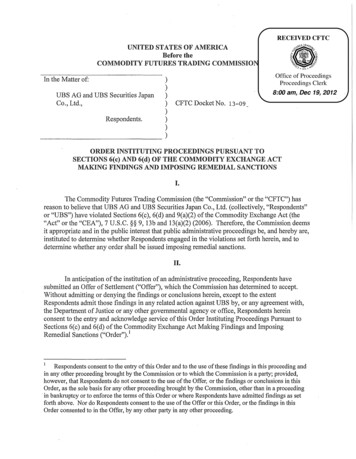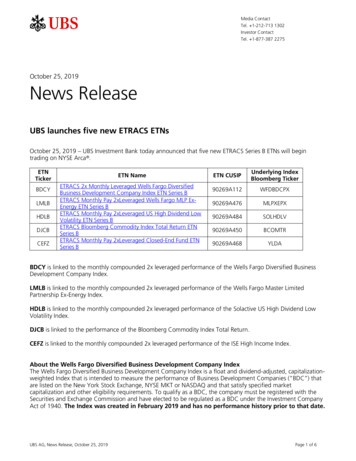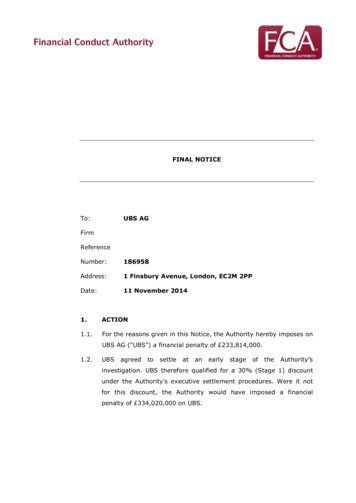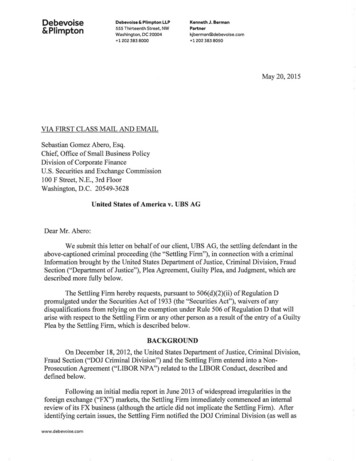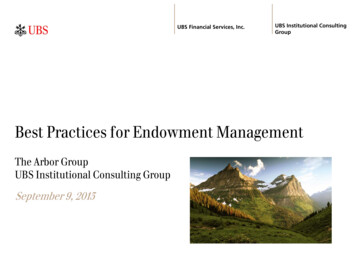
Transcription
UBS Financial Services, Inc.UBS Institutional ConsultingGroupBest Practices for Endowment ManagementThe Arbor GroupUBS Institutional Consulting GroupSeptember 9, 2013
The Arbor Group's commitment to conservationFOR MARKETING PURPOSES BY UBSThe Arbor Group helps to conserve and improve critically importantecosystems and their inhabitants worldwide. We accomplish this by throughinvestment consulting, generating consistent funding for Conservation TrustEndowments that are managed in perpetuity.
Best practices for foundations and endowmentsFOR MARKETING PURPOSES BY UBS Investment policy development Asset allocation modeling and rebalancing Investment manager search, identification andrecommendation Ongoing consulting and performance measurement The role of the consultant in the investment process
FOR MARKETING PURPOSES BY UBSInvestment policyBest practicesThe Arbor GroupJason Hamlin, CIMA, CRPCWealth StrategistUBS Institutional Consulting Group
Successful investing requires a processOn-goingConsulting andPerformanceMeasurementInvestment PolicyPlanningAssistanceFoundation, Trust Fundor EndowmentManager Search,Identification &RecommendationAsset AllocationModeling andRebalancingFOR MARKETING PURPOSES BY UBS
FOR MARKETING PURPOSES BY UBSInvestment policy developmentInvestment goals & objectivesAppropriate time horizonAsset allocation development*Responsibilities and duties delegatedOtherGeneral investment principlesAcceptable investment vehiclesAsset Allocation guidelinesInt'lEquityU.S. EquityU.S. Fixed IncomeMission Related Investing criteriaRisk managementSpending policy* For Illustrative Purposes OnlyInvestment Mgr. Review & Evaluation5
Establishing an appropriate spending policyFor neworganizations, itmay be helpful toestablish a sinkingfund to meet initialspending needs.Annual spendingrates in excess of5% can lead tolong termchallenges.FOR MARKETING PURPOSES BY UBSExample Spending PolicyTotal Return7.5% Grants, Gifts, Fees1.5%-Payout %-5.0%Investment and Administration-0.8%Inflation-2.2%Real Growth1.5%
FOR MARKETING PURPOSES BY UBSImportance of asset allocationStrategic asset allocation can help manage portfolio risk while stabilizing 4.6%Other2.1%Market Timing1.8%According to a study by UBS, asset allocation accounts for 91.5% of the“variationin portfolio returns.”1 Gary P. Brinson, L. Randolph Hood and Gilbert L. Beebower, “Determinants of Portfolio Performance,” The Financial Analysts Journal, July/August 1986; and Gary P. Brinson,Brian D. Singer and Gilbert L.Beebower, “Determinants of Portfolio Performance, II: An Update,”The Financial Analysts Journal, May/June 1991.2Asset allocation, however, does not assure a profit or prevent against loss from occurring in an investment portfolio.Source: Page 42 of GLAM Investor Insights of June 30th, 20097
Equities have protected purchasing power over timeGrowth of 10,000 from 1925 – December 31, 2011 100,000,000 10,000,000 1,000,000 100,000 19971999200120032005200720092011 1,000S&P 500 Index 28,850,620US LT Gov't 1,197,22990-day US T bill 229,290US Inflation 126,073Note: 10,000 may not be representative of a typical investment in 1925.Source: Ned Davis Research; used with permission. The chart is shown for illustrative purposes only, and is not meant to show the returns of any particular UBS Global AssetManagement investment. Stocks represented by Standard & Poor’s (S&P) 500 Index, long-term government bonds by 20-year US Treasury bonds, 90-day US Treasury bills and inflation by theConsumer Price Index (CPI through December 31, 2011). The S&P 500 Index is an unmanaged, weighted index comprising 500 widely held common stocks varying in composition. Returns consistof income, capital appreciation (or depreciation) and currency gains (or losses). Certain markets have experienced significant year-to-year fluctuations and negative returns from time to time.Stocks are more volatile and subject to greater risks than other asset classes. Indexes are not available for direct investment. Past performance is not a guarantee of future results.US-R8
FOR MARKETING PURPOSES BY UBSAsset allocationBest practicesThe Arbor GroupPatrick T. Drum, CFA, CFPFinancial AdvisorPortfolio Manager
FOR MARKETING PURPOSES BY UBSModern portfolio theoryPortfolio optimization to create higher predictability in returns.What we know: capital markets history Historical returns of asset classes Historical variability of returns from asset classes Historical correlations between asset classesWhat we can input: (investment policy) Return expectations Risk tolerance Asset class preferences and allocation constraints Time horizon to meet objectives Economic forecast for capital marketsWhat we can determine Efficient frontier of optimal portfolios Expected returns at given levels of expected risk
The importance of strategic asset allocationFOR MARKETING PURPOSES BY dsBondsReturnStrategic Asset Allocation:The appropriate mix of asset classes based on long-term market assumptions (10 years) given an investor's objectives and risk tolerance. The optimalportfolio depends on the preferences and the risk profile of the investor.Efficient frontier lineOptimalportfolioEquityCommoditiesReal EstateEquityHedge FundsReal EstatePrivate EquityStrategic Asset Allocation of an initial and optimized portfolio.Sub-optimalportfolioRiskThe efficient frontier line represents the portfolios with the lowestrisk for each given return level. These portfolios are called"efficient" portfolios.11For illustrative purposes only. Please refer to the disclaimer at the end of this presentation
Stocks and bonds: risk versus returnThis image illustrates an efficient frontier for all combinations of two asset classes: stocks and bonds. 1970 – 201012%Return80% Stocks, 20% Bonds11An efficient frontier represents every possiblecombination of assets that maximizes return at eachlevel of portfolio risk and minimizes risk at each level ofportfolio return.60% Stocks, 40% Bonds50% Stocks, 50% Bonds10Maximum risk portfolio:100% StocksAn efficient frontier is the line that connects all optimalportfolios across all levels of risk. An optimal portfolio issimply the mix of assets that maximizes portfolio returnat a given risk level.Minimum risk portfolio:28% Stocks, 72% Bonds100% Bonds910% Risk111213141516171820Past performance is no guarantee of future results. Risk and return are measured by standard deviation and arithmetic mean, respectively. This is for illustrative purposes only and not indicative of any investment.Stocks in this example are represented by the Standard & Poor’s 500 , which is an unmanaged group of securities and considered to be representative of the stock market in general and bonds by the 20-year U.S. government bond. Risk andreturn are based on annual data over the period 1970–2010 and are measured by standard deviation and arithmetic mean, respectively. Standard deviation measures the fluctuation of returns around the arithmetic average return of theinvestment. The higher the standard deviation, the greater the variability (and thus risk) of the investment returns. An investment cannot be made directly in an index. The data assumes reinvestment of all income and does not account fortaxes or transaction costs.Stock represent ownership in a corporation, while bonds, if held to maturity, offer a fixed rate of return and fixed principal value. 2011 Morningstar. All rights reserved. 3/1/201112
Diversification in bull and bear marketsby diversifying among the two asset classes, the diversified portfolio experienced less severe monthly fluctuations thanstocks or bonds alone.Bull marketBear market 2,500 1,500Stocks50/50 portfolioBonds 2,0842,0001,250 1,160 1,6531,5001,000 1,2741,000750500500Oct 2002 Oct 2003 Oct 2004 Oct 2005 Oct 2006 Oct 2007This graph illustrates the hypothetical growth of 1,000 in stocks, bonds,and a 50% stock/50% bond diversified portfolio from October 2002 toOctober 2007. 767Nov 2007Nov 2008 491This graph illustrates the hypothetical growth of 1,000 in stocks,bonds, and a diversified portfolio between November 2007 andFebruary 2009.Past performance is no guarantee of future results. This is for illustrative purposes only and not indicative of any investment. An investment cannot be made directly in an index. Stocks in this example are represented by the Standard & Poor’s500 , which is an unmanaged group of securities and considered to be representative of the stock market in general, and bonds by the 20-year U.S. government bond. An investment cannot be made directly in an index. The data assumesreinvestment of income and does not account for taxes or transaction costs. The bull market analyzed is defined by the time period October 2002—October 2007, and the bear market by the time period November 2007—February 2009.Diversification does not eliminate the risk of experiencing investment losses. Government bonds and Treasury bills are guaranteed by the full faith and credit of the United States government as to the timely payment of principal and interest,while stocks are not guaranteed and have been more volatile than bonds.Stock represent ownership in a corporation, while bonds, if held to maturity, offer a fixed rate and fixed principal value. 2011 Morningstar. All rights reserved. 3/1/20114
FOR MARKETING PURPOSES BY UBSTactical asset allocationThe ultimate goal of aTactical Asset Allocationis to profit from shortterm investmentopportunities withoutsignificantly alteringthe long-term riskprofileMarket cyclePhase 1BondsBonds outperformas the economyslowsPhase 2EquitiesStocks do wellwhen theeconomy initiallyrecoversInterest rate cutsOverweight bondsOverweight equitiesUnderweight liquidityPhase 3Equities & CommoditiesPhase 4Money MarketInterest rate hikesStocks are still attractive(positive earnings effect).Commodities usuallyperform well when theoutput gap disappearsCash is a safe haven whengrowth slows from theabove trend, and risingunit costs trigger a (wage)price spiral (inflation risks)Neutral equitiesUnderweight bondsOverweight cashUnderweight equitiesFor illustrative purposes onlyPlease refer to the disclaimer at the end of this presentation14
Mission Related InvestingFOR MARKETING PURPOSES BY UBSESGEnvironmental, Social and Governance screeningScreening Prudent management of environmental and social aspects of acompany can help increase efficiency and reduce operational costs,contribute to attracting and retaining employees, enhancing thecompany’s reputation and reducing its exposure to risk. Investing incompanies that have sustainable business foundations and strategiesmay therefore also pay off financially. Excludes investments that are unacceptable on ethical, environmentalor social grounds (e.g. weapons, gambling, alcohol, tobacco) Includes "best in class" social and environmental leaders within theirindustriesAn investmentphilosophy whichconsiders social andenvironmental valuesalongside financialreturns as criteria forselecting an investmentopportunity.ThematicExamples include Clean Energy, Renewable Energy, WaterInvesting We identify mega-trends that can change the world in terms ofenvironmental and social practices. We seek to invest in companies thatrecognize such opportunities and have great growth potential byoffering products and services that contribute to solving challenges onthe way towards a more sustainable world.ImpactInvesting Actively placing capital in businesses and funds that generate socialand/or environmental good. Target returns thereby range from returnof principal capital to market or even above-market financial returns.
Risk management strategiesFOR MARKETING PURPOSES BY UBS Strategic portfolio rebalancing Tactical asset allocation Use of low and negatively correlated asset classes Identification and defensive use of equity manager captureratios Tactical adjustment of index vs. active equity managers Mathematical “market breaker” risk reduction system Optimal curve allocation adjustment Risk budgeting Use of “Bear” exchange traded funds (ETFs) for hedging risk Principal protected notes
FOR MARKETING PURPOSES BY UBSRebalancing can help to manage volatilityPortfolios that are rebalanced even once per year are significantly less volatile thanportfolios that have not been rebalanced20.0%10.0%Without Rebalancing:More variability and downside risk9.60%0.0%-10.0%-20.0%With Rebalancing:Less variability and downside risk9.50%-4.70%-13.40%Average Annual Returns (%)Maximum 12-month loss (%)Source: UBS Global Asset Management. For illustrative purposes only. The example above is based on a hypothetical portfolio consisting of 40% S&P 500 Index and 60% Lehman Treasury Index. Theindices are unmanaged and are not available for direct investment. The portfolio rebalanced annually was rebalanced every January during the 20-year period. Maximum loss is based on any rolling12-month period during the 20-year period. Past performance is no guarantee of future results. Rebalancing alone does not ensure gains or prevent losses from occurring in a portfolio or account.Source: Page 45 of Investor Insights of June 30th, 200917
FOR MARKETING PURPOSES BY UBSInvestment manager review and evaluationBest practicesThe Arbor GroupJason Hamlin, CIMA, CRPCWealth StrategistUBS Institutional Consulting Group
FOR MARKETING PURPOSES BY UBS"Best-in-class" investment managers screening processBest in Class managersDiscussion and decisioneligiblemanagersDue DiligenceCollect and analyze informationUnderstand investment philosophy and processVerify and build convictionPreliminary selectionManager UniverseIdentify candidates based on asset classor stylebeingsoughtQualitativeand Quantitative85analysis and evaluationUniverse of availablemanagers
FOR MARKETING PURPOSES BY UBSEvaluating the risk each manager takes to achieve returnsBest Practice: Have access to the right tools
Monitoring individual investment managersFOR MARKETING PURPOSES BY UBS
FOR MARKETING PURPOSES BY UBSEvaluating investment managers downside captureIt may be desirable to find managers that do better in tough market conditions than their peers
FOR MARKETING PURPOSES BY UBSOngoing consulting and reviewBest practicesThe Arbor GroupCarlos L. ObandoFirst Vice President-InvestmentsSr. Consulting Group Associate
FOR MARKETING PURPOSES BY UBSThe quarterly review processStandard format for our quarterly review with the Trust Investment CommitteeEconomic OverviewAsset Allocation Recommendation Commentary on key economic events Portfolio changes to move to target allocation Economic forecast from the investment firm’s chiefeconomist Investment managers to be replaced Investment managers to be hired A review of the quarterly and trailing annual totalreturn of major investment markets and industries Intra-account transfers to achieve target allocationInvestment Account OverviewDiscussion with the Board Investment Committee Question and Answer periodComment on major receipts or disbursements Board requests for additional information Restatement of the institution’s investment policy A review of the institution’s current target allocationConsultant provides action plan in writing to theFinance Committee for approval or amendment Current balance of accounts Investment Performance Review Total return report- prior quarter and year Comparison to primary benchmarks (risk adjustedreporting) Statement of current asset allocation Comparison to the institution’s current target allocationInvestment Manager Review Performance review of sub-accounts Managers with exceptional performance: evaluatereturns Managers with negative returns or under-performingbenchmarks: evaluate returns Managers placed on watch listFollow-through Approval by Board to proceed with recommendations Portfolio changes are made to move to target allocation Confirmations provided to the Finance Committee
Providing effective oversightConsolidated view of asset allocation and performance over multiple time periodsFOR MARKETING PURPOSES BY UBS
Monitoring adherence to investment policy limitsFOR MARKETING PURPOSES BY UBS
FOR MARKETING PURPOSES BY UBSState of the art diagnostic tools for informed decision making
FOR MARKETING PURPOSES BY UBSEvolution of single manager to multi-manager consultingBest practicesThe Arbor GroupJohn S. Adams, CFP, CIMASenior Vice President-InvestmentsSr. Portfolio Manager
FOR MARKETING PURPOSES BY UBSInvestment manager relationshipHiring investment managers directly takes a lot of time and continually updated expertiseClientInvestment managerChallenges: Limited asset allocation advice Not a 'best in class' strategy May lack needed performance reporting capabilities May lack monitoring expertiseClientLg Cap GrowthManagerLg Cap ValueManagerSt Term Fix Inc Int Term Fix IncManagerManagerU.S. Mid CapManagerU.S. Small CapManagerInt'l EquityManagerLg Term Fix IncManagerAlternativeManagerReal AssetManagerChallenges: Need tools necessary to evaluate 'best in class' investmentmanagers Receive separate (unconsolidated) performance reports Adherence to investment policy is managed by the client May lack monitoring expertise
FOR MARKETING PURPOSES BY UBSInvestment consulting relationshipHiring an investment consultant saves time and likely improves oversightClientSolutions Receive consolidatedinformation to be able to makeinformed decisions Improved due diligence andoversight of the investmentprocessInvestmentconsultant"Best in Class" investment managersLg Cap GrowthManagerLg Cap ValueManagerSt Term Fix Inc Int Term Fix IncManagerManagerU.S. Mid CapManagerU.S. Small CapManagerInt'l EquityManagerLg Term Fix IncManagerAlternativeManagerReal AssetManager
Best practice takeawaysFOR MARKETING PURPOSES BY UBS Engage a qualified investment consultant through a competitive bid process Develop a comprehensive investment policy and review regularly Design the portfolio to achieve specific objectives and avoid potentialsetbacks Hire top ranked managers Monitor performance against accomplishment of established criteria Dedicate to continual education Consider hiring a consultant
FOR MARKETING PURPOSES BY UBSAppendix AAbout The Arbor Group
FOR MARKETING PURPOSES BY UBSThe Arbor Group31 Years in financial industry45 Years playing classical guitar1 Lifelong passion for conservation26 Overseas trips3 Languages spoken fluently2 Sons in college, multiple checks written20 Years in financial industry6 Trips to Seattle Mariners spring training1 Epic kayak adventure in MexicoJohn is Director of the Arbor Group. He is aCertified Financial Planner, Certified InvestmentManagement Analyst, and has a master's degreein Management and a Master's Degree inFinancial Services. Prior to the financial field Johnwas a concert classical guitarist.Carlos was born in Guayaquil, Ecuador and movedto Brooklyn, NY when he was six years old. Heattended Stuyvesant High School, Duke University(cum laude degree in Engineering) and HarvardBusiness School, where he earned his MBA in 1983.Patrick worked at Morgan Stanley and atWashington Mutual as a member of the CapitalMarkets Group prior to UBS. Patrick is a SeniorPortfolio Manager, Chartered Financial Analyst(CFA) charter holder, Certified Financial Plannerand obtained his MBA from Seattle University in2007.John and his wife Andrea have three childrenand live on Bainbridge Island. He is an avidmountaineer and amateur wildlife photographer.Team RoleSenior Portfolio Manager – EquitiesInstitutional ConsultingDirectorContact InformationJohn S. Adams, CIMA, CFPjohn.s.adams@ubs.com206-628-8554Carlos enjoys international travel, skiing and modernart. He is active with and has been President of theMIT Enterprise Forum of the Northwest.Team RoleSenior Portfolio Manager – EquitiesInternational Trust Fund consultingContact InformationCarlos Obandocarlos.obando@ubs.com206-447-2407Patrick has two children. He enjoys the SeattleMariners, the Tacoma Rainiers, sea-kayaking andgolfing.Team RoleSenior Portfolio Manager – Fixed IncomeBusiness owner transition planningContact InformationPatrick T. Drum, CFA, CFPpatrick.drum@ubs.com206-447-2450
FOR MARKETING PURPOSES BY UBSThe Arbor Group22 Countries visited and counting16 Years in financial industry1 Lifelong love for animals14 Years serving on non-profit boards9 Years living in Alaska3 High energy, elementary school aged boys76 Countries visited, including 54 for work2 Companies co-founded (both still exist)2 National sailing championship titlesStephanie is a Financial Advisor, Certified FinancialPlanner and holds a Wealth Management Certification.She has extensive background in wealth managementservices that includes corporate asset management, highnet-worth planning, business retirement programs,chartable giving, and employee stock options.Jason is a Wealth Strategy Associate, Chartered RetirementPlanning Counselor and Certified Investment ManagementAnalyst. Jason earned his CIMA designation from theWharton Business School. He has been with UBS for 7 years.Leo is a Financial Advisor. He was born, raised andeducated in the Netherlands, and moved to the US in1993. He has Bachelors degrees in ChemicalEngineering and Economics, and a MBA from what isnow Erasmus University in the Netherlands. His firstjob was to manage foreign currency exposures for KLMRoyal Dutch Airlines in the Netherlands.Stephanie earned a B.A. in political science fromWashington State University and has completedpostgraduate work in finance at the University ofWashington. Stephanie currently resides in Magnoliawith her husband and her pets.Team Role / specialtiesFinancial planningWealth management strategiesContact InformationStephanie Honan, CFPstephanie.honan@ubs.com206-287-8805Jason serves on the board of the Woodland Park Zoo andCommunity Health Center of Snohomish County. He wasPresident of the Greater Wasilla Chamber of Commerce andserved on multiple high profile boards. He was one ofAlaska's 'Top 40 Under 40' in 2009. Jason has been marriedto his wife Joey for 16 years. He likes to play sports, hike, playguitar and cheer for Seattle sports teams with his family.Team Role / specialtiesPortfolio analysis, asset allocation and investment managerresearchInstitutional consultingContact InformationJason Hamlin, CIMA, CRPCjason.hamlin@ubs.com206-447-2465Leo has 3 children. He enjoys boating, biking, hikingand skiing. He is Vice-Chair Finance for the SeattleSymphony Orchestra and sits on the Boards ofBenaroya Hall Music Center and some other local notfor-profit organizations.Team Role / specialtiesClients with international financial situationsEquity analysisContact InformationLeo van DorpLeo.vandorp@ubs.com206-689-3126
FOR MARKETING PURPOSES BY UBSThe Arbor Group13 Years in financial industry4 Years teaching English in Japan1 Cat that is now husband's best friend15 Countries visited6 Years in financial industry1 Lifelong passion for animal rescue100 Thousand miles on a bicycle16 Solar panels on home1 Bike shop ownedTom is a Senior Registered Client Service Associate.He provides administrative support and clientservice for our team and has over 10 years ofexperience in the financial service industry.In her spare time, Deena enjoys Japanesegardening, her book club, playing the violin andtraveling with her husband.Krystle brings over 6 years experience in theaccounting/finance industry to our team. She holds aBachelor of Science degree from the University ofPortland and then went on to obtain a PostBaccalaureate Accounting Certificate from Portland StateUniversity. Krystle started her career in public accountingat KPMG LLP before transitioning into financial services.She is a native of Portland, Oregon and relocated toSeattle two years ago. She provides team administrationand a high level of client service. In her spare time, sheenjoys spending time with her husband and twobulldogs, hiking, ballroom dancing and just beingoutdoors in the beautiful Pacific Northwest.Team RoleAdministrative assistanceTeam RoleTeam administratorTeam RoleAdministrative assistanceContact InformationDeena Fuller, CRPCdeena.fuller@ubs.com206-447-2418Contact InformationKrystle t InformationTom Aguirretom.aguirre@ubs.com206-287-8799Deena is a Registered Paraplanner, SeniorRegistered Client Service Associate, andChartered Retirement Planning Counselor. Sheprovides administrative support and clientservice. After graduating from Seattle Universityshe traveled throughout Asia and began hercareer teaching English as a Second Language inJapan and then returned to teach high school inthe Seattle area.After graduating from California State University,San Bernardino he was a Peace Corps volunteer inNiger, West Africa. Prior to working in finance, hewas in the bicycling industry. In his spare time, heenjoys bicycling, painting and spending time withhis wife and family.
DisclaimerFOR MARKETING PURPOSES BY UBSThis document and the information contained herein are provided solely for information purposes, they are not to be regarded as investment research, and they are not to beconstrued as an offer or as a solicitation of an offer to buy or sell any securities or other financial instruments in Switzerland, the United States or any other jurisdiction. Pleasenote that UBS retains the right to change the range of services, the investment products and the prices at any time without prior notice and that all information and opinionsindicated are subject to change. Further, asset classes, asset allocation and investment instruments are indicative only.No investment decision relating to securities of or relating to UBS AG or its affiliates should be made on the basis of this document. All investments carry a certain degree of riskand the attention is hereby drawn to such risks which can be substantial. The market in the certain securities may be illiquid and therefore valuing the investment and identifyingthe risks may be difficult. Some investments may be subject to sudden and large falls in value and on disposition may pay back less than invested. The client should consult theUBS client advisor on the nature of each investment and carefully consider whether such investment is appropriate for the client's situation. Further, tax treatment depends onthe individual client’s circumstances and may be subject to change in the future. UBS does not provide legal or tax advice and makes no representations as to the tax treatmentof assets or the investment returns thereon, either in general or with reference to a specific client's circumstances and needs. Clients should obtain independent tax advice onthe suitability of products, assets or investment instruments before investing and as they may consider appropriate.This document contains statements that constitute "forward-looking statements", including but not limited to management’s outlook for UBS’s financial performance andstatements relating to the anticipated effect of transactions and strategic initiatives on UBS’s business and future development. While these forward-looking statementsrepresent UBS’s judgments and expectations concerning the matters described, a number of risks, uncertainties and other important factors could cause actual developmentsand results to differ materially from UBS’s expectations. These factors include, but are not limited to: (1) future developments in the markets in which UBS operates or to whichit is exposed, including movements in securities markets, credit spreads, currency exchange rates and interest rates; (2) the effect of the current economic environment or otherdevelopments on the financial position or creditworthiness of UBS’s customers and counterparties; (3) changes in the availability of capital and funding, including any changes inUBS’s credit spreads and ratings; (4) the consequences of the recent Swiss court decision relating to the provision of certain UBS client data to the US Internal Revenue Service,including possible effects on UBS’s 2009 settlements with US authorities and on its businesses; (5) the outcome and possible consequences of pending or future actions orinquiries concerning UBS’s cross-border banking business by tax or regulatory authorities in various other jurisdictions; (6) the degree to which UBS is successful in effectingorganizational changes and implementing strategic plans, and whether those changes and plans will have the effects intended; (7) UBS’s ability to retain and attract theemployees that are necessary to generate revenues and to manage, support and control its businesses; (8) possible political, legal and regulatory developments, including theeffect of more stringent capital and liquidity requirements, constraints on remuneration and the imposition of additional legal or regulatory constraints on UBS’s activities; (9)changes in accounting standards or policies, and accounting determinations affecting the recognition of gain or loss, the valuation of goodwill and other matters; (10)limitations on the effectiveness of UBS’s internal processes for risk management, risk control, measurement and modeling, and of financial models generally; (11) changes in thesize, capabilities and effectiveness of UBS’s competitors; (12) the occurrence of operational failures, such as fraud, unauthorized trading and systems failures, either within UBSor within a counterparty; and (13) technological developments. In addition, actual results could depend on other factors that we have previously indicated could adversely affectour business and financial performance which are contained in our past and future filings and reports, including those filed with the S
UBS Institutional Consulting Group September 9, 2013 UBS Financial Services, Inc. FOR MARKETING PURPOSES BY UBS The Arbor Group's commitment to conservation The Arbor Group helps to conserve and improve critically important ecosystems and their inhabitants worldwide. We accomplish this by through


